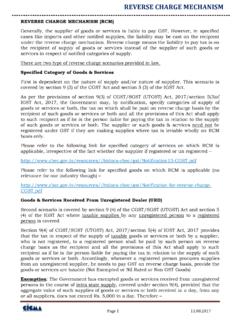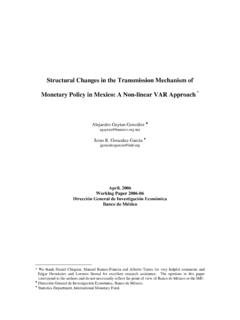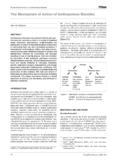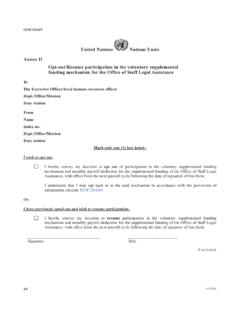Transcription of The Design and Optimization of a Crank-Based Leg …
1 The Design and Optimization of a Crank-Based Leg Mechanism Amanda Ghassaei Professors Phil Choi and Dwight Whitaker Pomona College Department of Physics and Astronomy April 20, 2011ii Table of Contents iii iv Chapter 1: Introduction .. 1 Summary of 1 Advantages of 1 3 Chapter 2: 5 5 Crank based Walking 5 Gait Selection for 2n-Walking 12 Chapter 3: Survey of Walking mechanisms and Analysis in 23 23 Hrones-Nelson 24 Theo Jansen 25 Chapter 4: Design and Analysis of Walking 45 45 Design 46 Chapter 5: Optimization of Walking 55 55 Symmetry of 56 Four Bar Linkage #1 57 Full Linkage 59 Chapter 6.
2 Analysis and Comparison with Theo 63 63 Position 63 Locus 67 Center of Analysis of Linkage 72 Comparison with Theo Jansen 76 Chapter 7: Construction and 79 79 79 Comparison with Theoretical 96 Possible Improvements/ Future 97 Appendix A: Mathematica 98 Appendix B: Theo Jansen Appendix C: Optimization of Four Bar Linkage # 151 Appendix D: Optimization of Four Bar Linkage # 161 Works 168 iii Abstract This paper describes the Design and fabrication process of a 2n-legged passive walker based on the work of Theo Jansen; the primary focus of this paper is the Design of a Crank-Based leg linkage.
3 The linkage was simulated in Mathematica, and an analysis of the leg Design , including an analysis of the foot path and center of mass is provided and compared to the Theo Jansen mechanism. The results of the comparison found that the foot path of the new Design is flatter and has a more constant velocity when it is in contact with the ground and the leg linkage requires 85% less vertical center of mass movement during locomotion than the Theo Jansen mechanism, but its step height is about 33% less. A detailed description of the fabrication of a six-legged walker made primarily from PVC tubing is given, as well as suggestions for improvement and future I would like to thank David Haley, Glenn Flohr, Tony Grigsby, Cathi Combras, Jenna deBoisblanc, Phil Choi, Dwight Whitaker, and the rest of the Pomona Physics and Astronomy Department for their contributions to this project.
4 1 Chapter 1: Introduction Summary of Paper The purpose of this paper is to describe the Design and construction process of a2n-legged walking machine suitable for locomotion in variable terrain. In this paper I will accomplish the following: x A discussion of Crank-Based linkages for the purpose of walking. x An introduction to gait analysis. x A quantitative and qualitative analysis of Crank-Based linkage examples and an assessment their suitability for walking. x An outline of my Design objectives. x A quantitative and qualitative analysis of my Design . x An explanation of the Optimization process.
5 X A description of the techniques I used to build a physical model of my linkage. x A discussion of possible improvements on my Design and future work. Advantages of Walking Walking machines possess several advantages over wheeled machines in areas of variable terrain. Consider a wheel moving a constant velocity V; every point on its perimeter is moving at a constant velocity V tangent to the curve of the wheel as shown in Figure A comparable walking mechanism would be one which moves at a constant velocity V, and where the foot of the walker traces out a similar circular path with a constant velocity V at all points on the path (also shown in Figure ).
6 The most obvious advantage of the foot over the wheel is that the foot may step over inconsistencies in the terrain. Local maxima and minima may be completely avoided by simply stepping over them. This results in less loss of energy during locomotion and allows the vehicle to maintain a constant velocity and height over variable terrain. 2 Figure : Comparison of wheel and foot response to a local maximum in the terrain. The dotted lines indicate the perimeter of the wheel or the path of the foot. The arrows indicate the direction of movement. The foot may step over the obstacle completely, while the wheel must move over the obstacle.
7 Now consider a case where the comparable foot and wheeled systems approach an obstacle that cannot be avoided, as shown in Figure When the edge of the wheel makes contact with the higher ground, it forces the velocity of the vehicle to immediately slow. This edge has a total velocity V, but only a fraction of that velocity is in the x direction, so the vehicle quickly slows from V to Vx2. The foot encounters a similar change in velocity, but it has the advantage of being able to slide along the ground. Although this scenario is not ideal, dragging the front foot across the raised terrain reduces change of velocity in the x direction.
8 Both models must still overcome the potential energy barrier posed by the increased height of the terrain. Figure : A comparison of a wheel and a foot (moving in a wheel-like path) approaching an inconsistency in the terrain. The x component of the velocity of the edge of the wheel and the foot s path are indicated. Furthermore, the wheel causes a great deal of environmental harm3. Its inability to avoid obstacles means that it erodes more terrain than a foot when moving comparable 3 vehicles. Additionally, wheeled vehicles work best on terrain with no inconsistencies; this has led to paving of many permanent roadways, another form of environmental degradation.
9 The benefits of walking over rolling on rough terrain are summed up in the following: x Higher energy efficiency, better fuel economy x Increased speed x Greater mobility x Improved isolation from terrain inconsistencies x Less environmental damage (both from paving and erosion) Objectives The aim of this project is to create an energy efficient mechanism for the movement of a vehicle over variable terrain. My objectives are discussed below: x Energy efficiency In my Design I want to minimize the amount of energy used per locomotive cycle. I will accomplish this by designing a linkage which minimizes torque on the crank and sequencing a gait in which the upward movement of one leg is cancelled out by the downward movement of another leg; this necessitates that the walker have 2n legs.
10 Additionally, these legs must be attached to a central crank axis (as seen in Figure ) so that they can be coupled. The legs will all be directly coupled to the same crank axis. The linkage will also allow the main body of the vehicle to remain at a constant height throughout locomotion, which will minimize energy losses due to changing potential energy. Figure : Diagram of 2n legged walker with central crank axis labeled. 4 x Ability to avoid obstacles by stepping over them As I explained in the previous section, the main reason for choosing a walking mechanism over a wheel is that it has the ability to avoid obstacles.







